Black Desert, White Desert - Honestly
I am still puzzling about why I called that last post Black Desert White Desert when I didn't talk about either. I have a LOT of pictures. Remember that Kate usually sets these up so that clicking on one will lead to the rest of that series, though I think she will leave a couple for each category for those who are short of time. Spare a thankful thought for my wonderful blog fairy. She has, ever since I have started this blog, worked behind the scenes sprinkling fairy dust to make it easier for you to read. As I send it this is a mess. A mass of text – and a stream of photos and each becomes a different file and apparently a different blog entry. Kate organises it for me, dropping photos in where she thinks they should go, and making it all one manageable file. She set the blog up in the beginning so even a computer klutz like me can manage, and she is soon to come over for a holiday – and that will be great fun. As part of her break she will teach me how to do this stuff so her slavery will end. However – if anyone wants a brilliantly done web site (like mine) I can recommend Kate Andrews and Techies! As you can see – you do not even need to be in the same country. Her own blog is one of my favourites (after my son Sam's which I think is a brilliant read). See it in the side links – The Department.
You leave Bahariya Oasis and head south to go to both regions.
I had always had the Beau Geste image of an oasis as a neat little mound of palm trees visible from far horizons. In Egypt most oases are not up at desert level at all – they are in depressions which allow the palms to tap into ground water – often fossil water seeping up from miles down as it no longer rains in these areas. Both the black and white deserts are also in depressions in the terrain – but BIG.
Egypt has a lot of desert – and the word desert in Egyptian Arabic is Sahra – hence the Sahara. Around Cairo the desert is flat and gravely and very dull. Add in the fact that road workers leave grotty little piles of asphalt drums, the deep drag lines where they scrape up fill for the road bed, and that heavy rubbish chucked from car windows stays put and driving down a road through the desert is not necessarily an enchanting and romantic thing to do. Closer to Bahariya you get the impression that there are huge moles in the area as there are enormous sharp-pointed hills of sand everywhere. They process gravel here – and the sand is the result of the sifting process. Desert wind also sifts it through car windows as you drive and through your hair if you get out.
While not romantic though, it is really beautiful in the way a wide flat sea is beautiful. I find is seems to smooth me out, and make me feel at peace with the world. Perhaps some of this is simply getting away from Cairo.
The black desert is stark and dramatic. It is not really totally black, more light coppery-gold sand and grit covered with a crust of black. Magma oozed slowly through thousands of slits in the earth's crust and pooled in a shallow crust over the surface. It cooled, and in the thinnest part of the crust, and in the 'pipes' through which it reached the surface, it has cracked and broken into many rocks, pebbles to large lumps. In the thicker areas it pooled and became basalt rock. As the sand has blown away from the areas not well covered the mountains have emerged – each with a heavy basalt crust, and basalt chunks cascading down the sides. The basalt has kept the sand in place. I hope I am getting this right - our lovely guide explained it with drawings in the sand.
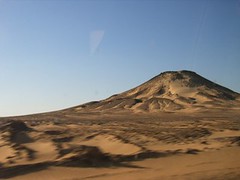
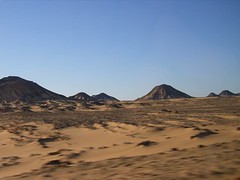
We took a shortish detour over the black desert. Our guide had two good friends in his car with him. As they approached an apparent precipice Stanze asked "Are we going down there?" There really wasn't time for an answer, as next second they went nose first over a hump so steep that I could imagine the car stuck on the ridge with all four wheels spinning in mid air and went straight down a very steep soft sand slope. We followed – and our driver, was Jim, Stanze's husband who is a very experienced four-wheel driver. Other than a brief check to make sure there actually was a drivable track he headed down. The last car was being driven by another good friend on his first ever desert drive. He is intrepid, and followed our tracks without a hesitation. However his passengers have renamed the large handles in four wheel drive vehicles – the ones that allow you to swing from the roof in really rough terrain. They now call them (warning – name might offend some readers!) the "Oh Shit" bars.
This bit of the trip was actually on our way back from the white desert. I am not writing this in chronological order, but in the order that you would arrive in each place as you drive from Bahariya. We drove straight through the Black Desert and past Crystal Mountain to the White Desert and did the rest on our way back.
Between the White desert and the Black Desert is the Crystal Mountain. This was explained to us as a place that has quartz crystals. I have been to places with quartz crystals and found myself searching through gravely stuff for pieces a few centimetres long. We bounced across the desert following our guide and hooked around a corner sliding in deep soft sand. I let out a shriek which had Bob muttering "Settle" as I started gabbling.
There was a gleaming shimmering blue-white crystal peak jutting from the sand beside us – so spectacular that I couldn't believe it. It was only a metre high – but HUGE crystals nestled together in tall columns. Then I realised as we pulled up (and thank goodness we stopped or I would have jumped from the window) that the hill behind was crested with crystals, and the shimmering sides were cascades of crystals – and so was the hill behind that.
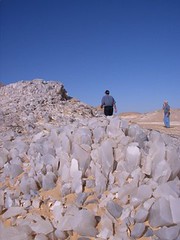
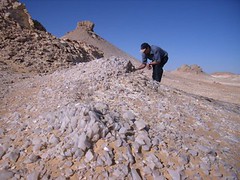
We have a strict policy of never breaking anything off – we collected some but took from tumbled areas. Bigger pieces were fragile and bits fell off as we carried them in our hats. On the whole I have a few spectacular but weathered large bits, and one could double as the icepick in whatever that terrifying Sharon Stone movie was! Also a good sized chunk but with smaller crystals that would not fall apart as I was interested in the way it is like a collapsed two storey garage with crystals instead of cars.
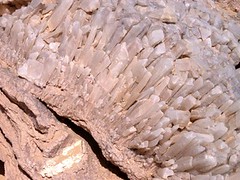
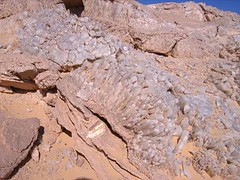
We had actually driven first to the White desert, so had arrived there in the morning. With the change from daylight saving the sun was already high. I think the way to see this would be to go to camp there as the shadows must be spectacular in early morning and late evening. I would love to see this with the softness of the violets and blues you would get in the evenings.
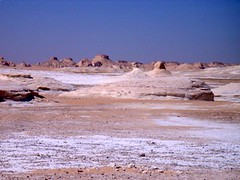
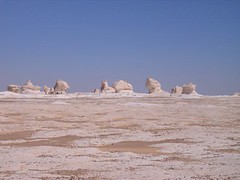
The terrain kept changing. You would go from little round hillocks to taller very phallic objects, to amazing twisted and weathered shapes that had us seeing them as people and chooks, and it was like spotting shapes in clouds. There are combinations of sand and pure white chalk everywhere you look, sometimes more sand and other times the whole world seems to be white.
Click on any of the photos below for more photos of tortured rocks in the desert.
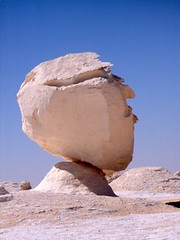
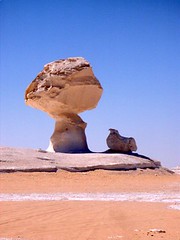
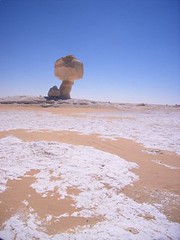
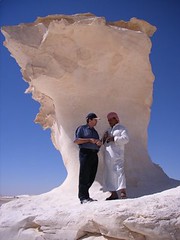
Peppered over the ground are tiny black spots – iron pyrites crystals in amazing shapes. Some are just shiny black pebbles, some look like those balls covered with points that mediaeval fighters would swing on chains. Others are like long sticks of coral, but I was told are crystallised pieces called pyrites pipes. Most of the ball-like shapes are about two centimetres across. When you break a pipe piece there is what looks like steel in the cross section – silvery and shiny.
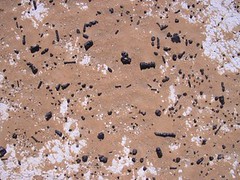
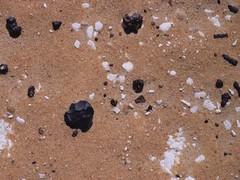
We stopped for lunch, boxed by the Hot Springs Hotel. Our guide promised shade, but with the sun directly above us whe could not see how he could deliver. There was a breeze, but it was glaring in the sun and hard to see how a lunch break could be shady. Even the various formations only had pools of shadow at their sides. Our guide found a tree. It was on a hill – an acacia like my grand daughter – and obviously survived and thrived on only night dew, as there is never rain here. It was a wonderful lunch, cool an delicious with golden wattle over our heads, dropping tiny golden balls into our hair and laps. We sat on one of Egypt's wonderful rag rags and our guide (who was fasting) made us tea with mint.
Click on the photo below for some more photos of our lunch in the desert.
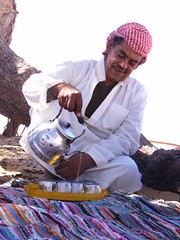
Tea for twelve
We drove through parts of the oasis next morning on the way to the lake – and it was so beautiful with dappling light through the palms and huge heavy burdens of red or gold fruit on the trees. It is such a generous crop, and relied on by people in the desert. The dates are crisp and slightly acrid when just ripe – and it is in the drying down stage that they go wet and sugary as we know fresh dates.
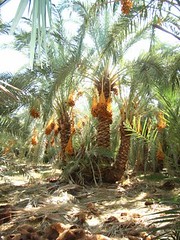
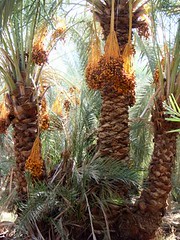
Golden dates, starting to dry on the palm
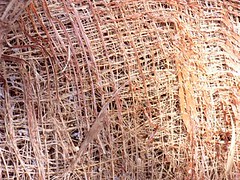
Nature's weaving, fibre from date palms
It was not part of the same day, but on the last morning we travelled through the oasis to the lake – which is rapidly becoming a salt lake, I was amazed that anything can grow near it. The edges are soft and sinking – dark mud and white crystals. The views are magnificent – pale and silvery with marvellous reflections.
Click on any of the photos below for more photos of the salt lake.
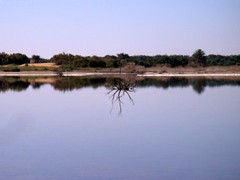
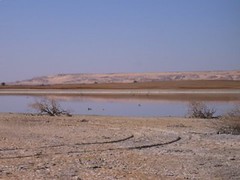
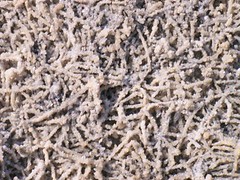
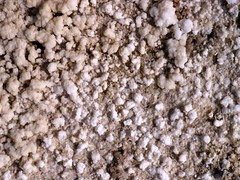
We called into the Bawiti village to buy olive oil and dates – both local produce and cheap. A litre of olive oil, dark green/gold and distinctively nutty cost us fifteen pounds – about three and a half Aussie dollars.
I photographed some local doors and windows. There was a whole street we had whistled through on our first day with distinctive wall paintings in ochres and terracotta colours, like in the tombs, I will go back and find them one day for photos.
Click on any of the photos below for more photos from Bawiti.
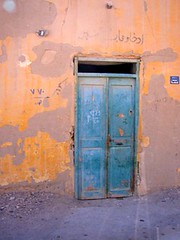
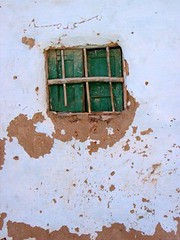
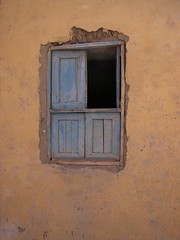
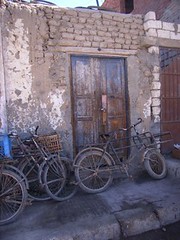
The last stops on the way back to Cairo were both to see fossils. We had noticed tree trunks on the way over – lying in sand. They were obviously petrified wood. I would be scared too if abandoned in the desert for millions of years.


Both a rock and a hard place
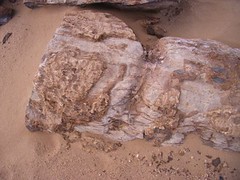
Wood grain detail
The other stop was at a fairly insignificant hill which is a nummilite or nummulite site. I found both spellings in Google but think the latter is correct. These are coin-like discs like thick golden stone pennies. They are the fossil remains of a member of the Foraminifera family. Where the discs have split into their two parts you can see the spiral whirls left by the animals chambers.
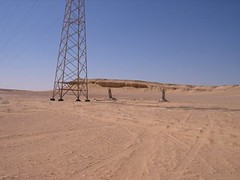
The nummulite hill
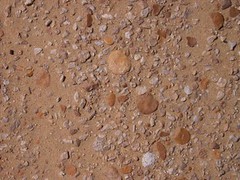
Nummulite scatter
It was a truly wonderful trip – and most of it only about six hour's drive from Cairo. I was weary after it, and am weary again after writing it up! Congratulations if you managed to read this far.
You leave Bahariya Oasis and head south to go to both regions.
I had always had the Beau Geste image of an oasis as a neat little mound of palm trees visible from far horizons. In Egypt most oases are not up at desert level at all – they are in depressions which allow the palms to tap into ground water – often fossil water seeping up from miles down as it no longer rains in these areas. Both the black and white deserts are also in depressions in the terrain – but BIG.
Egypt has a lot of desert – and the word desert in Egyptian Arabic is Sahra – hence the Sahara. Around Cairo the desert is flat and gravely and very dull. Add in the fact that road workers leave grotty little piles of asphalt drums, the deep drag lines where they scrape up fill for the road bed, and that heavy rubbish chucked from car windows stays put and driving down a road through the desert is not necessarily an enchanting and romantic thing to do. Closer to Bahariya you get the impression that there are huge moles in the area as there are enormous sharp-pointed hills of sand everywhere. They process gravel here – and the sand is the result of the sifting process. Desert wind also sifts it through car windows as you drive and through your hair if you get out.
While not romantic though, it is really beautiful in the way a wide flat sea is beautiful. I find is seems to smooth me out, and make me feel at peace with the world. Perhaps some of this is simply getting away from Cairo.
The black desert is stark and dramatic. It is not really totally black, more light coppery-gold sand and grit covered with a crust of black. Magma oozed slowly through thousands of slits in the earth's crust and pooled in a shallow crust over the surface. It cooled, and in the thinnest part of the crust, and in the 'pipes' through which it reached the surface, it has cracked and broken into many rocks, pebbles to large lumps. In the thicker areas it pooled and became basalt rock. As the sand has blown away from the areas not well covered the mountains have emerged – each with a heavy basalt crust, and basalt chunks cascading down the sides. The basalt has kept the sand in place. I hope I am getting this right - our lovely guide explained it with drawings in the sand.


We took a shortish detour over the black desert. Our guide had two good friends in his car with him. As they approached an apparent precipice Stanze asked "Are we going down there?" There really wasn't time for an answer, as next second they went nose first over a hump so steep that I could imagine the car stuck on the ridge with all four wheels spinning in mid air and went straight down a very steep soft sand slope. We followed – and our driver, was Jim, Stanze's husband who is a very experienced four-wheel driver. Other than a brief check to make sure there actually was a drivable track he headed down. The last car was being driven by another good friend on his first ever desert drive. He is intrepid, and followed our tracks without a hesitation. However his passengers have renamed the large handles in four wheel drive vehicles – the ones that allow you to swing from the roof in really rough terrain. They now call them (warning – name might offend some readers!) the "Oh Shit" bars.
This bit of the trip was actually on our way back from the white desert. I am not writing this in chronological order, but in the order that you would arrive in each place as you drive from Bahariya. We drove straight through the Black Desert and past Crystal Mountain to the White Desert and did the rest on our way back.
Between the White desert and the Black Desert is the Crystal Mountain. This was explained to us as a place that has quartz crystals. I have been to places with quartz crystals and found myself searching through gravely stuff for pieces a few centimetres long. We bounced across the desert following our guide and hooked around a corner sliding in deep soft sand. I let out a shriek which had Bob muttering "Settle" as I started gabbling.
There was a gleaming shimmering blue-white crystal peak jutting from the sand beside us – so spectacular that I couldn't believe it. It was only a metre high – but HUGE crystals nestled together in tall columns. Then I realised as we pulled up (and thank goodness we stopped or I would have jumped from the window) that the hill behind was crested with crystals, and the shimmering sides were cascades of crystals – and so was the hill behind that.


We have a strict policy of never breaking anything off – we collected some but took from tumbled areas. Bigger pieces were fragile and bits fell off as we carried them in our hats. On the whole I have a few spectacular but weathered large bits, and one could double as the icepick in whatever that terrifying Sharon Stone movie was! Also a good sized chunk but with smaller crystals that would not fall apart as I was interested in the way it is like a collapsed two storey garage with crystals instead of cars.


We had actually driven first to the White desert, so had arrived there in the morning. With the change from daylight saving the sun was already high. I think the way to see this would be to go to camp there as the shadows must be spectacular in early morning and late evening. I would love to see this with the softness of the violets and blues you would get in the evenings.


The terrain kept changing. You would go from little round hillocks to taller very phallic objects, to amazing twisted and weathered shapes that had us seeing them as people and chooks, and it was like spotting shapes in clouds. There are combinations of sand and pure white chalk everywhere you look, sometimes more sand and other times the whole world seems to be white.
Click on any of the photos below for more photos of tortured rocks in the desert.




Peppered over the ground are tiny black spots – iron pyrites crystals in amazing shapes. Some are just shiny black pebbles, some look like those balls covered with points that mediaeval fighters would swing on chains. Others are like long sticks of coral, but I was told are crystallised pieces called pyrites pipes. Most of the ball-like shapes are about two centimetres across. When you break a pipe piece there is what looks like steel in the cross section – silvery and shiny.


We stopped for lunch, boxed by the Hot Springs Hotel. Our guide promised shade, but with the sun directly above us whe could not see how he could deliver. There was a breeze, but it was glaring in the sun and hard to see how a lunch break could be shady. Even the various formations only had pools of shadow at their sides. Our guide found a tree. It was on a hill – an acacia like my grand daughter – and obviously survived and thrived on only night dew, as there is never rain here. It was a wonderful lunch, cool an delicious with golden wattle over our heads, dropping tiny golden balls into our hair and laps. We sat on one of Egypt's wonderful rag rags and our guide (who was fasting) made us tea with mint.
Click on the photo below for some more photos of our lunch in the desert.

Tea for twelve
We drove through parts of the oasis next morning on the way to the lake – and it was so beautiful with dappling light through the palms and huge heavy burdens of red or gold fruit on the trees. It is such a generous crop, and relied on by people in the desert. The dates are crisp and slightly acrid when just ripe – and it is in the drying down stage that they go wet and sugary as we know fresh dates.


Golden dates, starting to dry on the palm

Nature's weaving, fibre from date palms
It was not part of the same day, but on the last morning we travelled through the oasis to the lake – which is rapidly becoming a salt lake, I was amazed that anything can grow near it. The edges are soft and sinking – dark mud and white crystals. The views are magnificent – pale and silvery with marvellous reflections.
Click on any of the photos below for more photos of the salt lake.




We called into the Bawiti village to buy olive oil and dates – both local produce and cheap. A litre of olive oil, dark green/gold and distinctively nutty cost us fifteen pounds – about three and a half Aussie dollars.
I photographed some local doors and windows. There was a whole street we had whistled through on our first day with distinctive wall paintings in ochres and terracotta colours, like in the tombs, I will go back and find them one day for photos.
Click on any of the photos below for more photos from Bawiti.




The last stops on the way back to Cairo were both to see fossils. We had noticed tree trunks on the way over – lying in sand. They were obviously petrified wood. I would be scared too if abandoned in the desert for millions of years.


Both a rock and a hard place

Wood grain detail
The other stop was at a fairly insignificant hill which is a nummilite or nummulite site. I found both spellings in Google but think the latter is correct. These are coin-like discs like thick golden stone pennies. They are the fossil remains of a member of the Foraminifera family. Where the discs have split into their two parts you can see the spiral whirls left by the animals chambers.

The nummulite hill

Nummulite scatter
It was a truly wonderful trip – and most of it only about six hour's drive from Cairo. I was weary after it, and am weary again after writing it up! Congratulations if you managed to read this far.


8 Comments:
Two weeks to go!
Wow Mum, great post! Love the descriptions of the sites. I really hope I'll be able to see these places too...
Love, Sam.
Absolutely fascinating! It is marvellous the way you share it all with us.
Margaret from NZ
Fantastic detail! Thank you for sharing it with us. I find myself thinking "I wonder if I could claim a trip to Cairo as a tax deduction" as it is right up my vocational alley! I want to be on Crystal Mountain right now.
Hi Jenny
That was a fabulous description of the trip - about my favourite so far. I love the desert scenery, no matter where. Thanks for sharing the experience so vividly. Like Sam, I would love to visit some day.
Liz Needle
I like your Bawiti doors & windows portfolio.
Regards,
Peter
www.brypix.com
very impressive, I would love to be on a trip with you as the tour guide, you definitely see the most intertesting parts of everywhere you go. fascinating!
lol
Kim
Hi Jenny, just read your text. Absolutely fantastic descriptions that you write. Pics also amazing. How lucky you are to see and be in such wonderful places and thank you so very much for sharing with us. I can almost feel the heat and smell the earth.
Wendy from Kempsey. N.S.W.
Post a Comment
<< Home